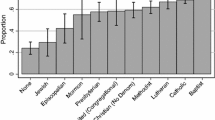Abstract
Regardless of the particular dimension of religiosity under consideration, women are generally found to be more religious than men. To date, empirical data has not been used to explore the importance of gender role ideology in explaining these differences. Using the 1988 Akron Area Survey, the effects of sex differences and gender role beliefs on six dimensions of religiosity are explored. The major findings include the following: (1) sex differences in religiosity are not supported for most dimensions of religiosity when other demographic variables are considered; (2) gender role ideology, while not sex related, does improve the explanation of variance in most dimensions of religiosity; and (3) sex is a predictor of the closeness of an individual's relationships to God, while gender role ideology is not. We suggest that stereotypes about women being more religious are misleading and that gender role ideology has an important effect on religiosity. However, sex is more indicative of the level of religious intimacy, measured by perceived closeness to God. We discuss the implications of this finding for changes in family structure and relationships between men and women.
Similar content being viewed by others
References
Adler, M. (1983). Women, feminism, and the craft. In L. Richardson & V. Taylor (Eds.), Feminist frontiers, Reading, MA: Addison-Wesley.
Anderson, M. L. (1988). Thinking about women: Sociological perspectives on sex and gender. New York: Macmillan Publishing.
Argyle, M. & Beit-Hallahmi, B. (1975). The social psychology of religion. Boston: Routledge & Kegan Paul.
Babbie, E. (1986). The practice of social research. Belmont, CA: Wadsworth Publishing.
Batson, D. C., & Ventis, W. (1982). The religious experience: A social psychological perspective. New York: Oxford University Press.
Chalfant, H. P., Beckley, R. E., & Palmer, C. (1987). Religion in contemporary society. Palo Alto, CA: Mayfield Publishing.
Chodorow, N. (1974). Family structure and feminine personality. In M. Z. Rosaldo & L. Lamphere (Eds.), Woman, culture and society. Stanford, CA: Stanford University Press.
Christ, G., & Plaskow, J. (1979). Womanspirit rising: A feminist reader in religion. NY: Harper & Row.
De Vaus, D., & McAllister, I. (1987). Gender differences in religion: A test of the structural location theory. American Sociological Review, 52, 472–481.
Gilligan, C. (1982). In a different voice: Psychological theory and women's development. Cambridge, MA: Harvard University Press.
Glock, C. Y., Ringer, B. B., & Bobbie, E. R. (1967). To comfort and to challenge: A dilemma of the contemporary church. Berkeley: University of California Press.
Gurin, P. (1985). Women's gender consciousness. Public Opinion Quarterly, 49, 143–163.
Hargrove, B. (1989). The sociology of religion: Classical and contemporary approaches. Arlington Heights: Harlan Davidson.
Jacobs, J. L. (1989, October). Religious experiences among men and women: A gender perspective on mystical revelation. Paper presented at the Society for the Scientific Study of Religion annual meeting, Salt Lake City, UT.
Johnstone, R. L. (1988). Religion in society: A sociology of religion (3rd ed.). Englewood Cliffs, NJ: Prentice Hall.
Lazerwitz, B. (1961). Some factors associated with variations in church attendance. Social Forces, 39, 301–309.
Lindsey, L. L. (1990). Gender roles: A sociological perspective. Englewood Cliffs, NJ: Prentice Hall.
McBroom, W. H. (1984). Changes in sex-role orientations: A five-year longitudinal comparison. Sex Roles, 11, 583–592.
McGuire, M. B. (1987). Religion: The social context. Belmont, CA: Wadsworth.
Pleck, J. (1977). Men's power with women, other men and society. In D. V. Hiller & R. A. Sheets (Eds.), Women and Men: The consequences of power. Cincinnati: University of Cincinnati Women's Studies.
Poloma, M. M., & Pendleton, B. F. (1990). Exploring types of prayer and the quality of life. Review of Religious Research, 31, 46–53.
Poloma, M., & Pendleton, B. F. (1991). Exploring neglected dimensions of religion in quality of life research. New York: The Edwin Mellen Press.
Renzetti, C. M., & Curran, D. J. (1989). Women, men, and society: The sociology of gender. Boston: Allyn and Bacon.
Richardson, L. (1988). The dynamics of sex and gender: A sociological perspective. New York: Harper & Row.
Roberts, K. (1990). Religion in sociological perspective (2nd ed.). Belmont, CA: Wadsworth.
Rubin, L. (1983). Intimate strangers. New York: Harper & Row.
Sapiro, V. (1990). Women in American society. Mountain View, CA: Mayfield.
Sattel, J. W. (1989). Men, inexpressiveness and power. In L. Richardson & V. Taylor (Eds.), Feminist Frontiers II. New York: Random House.
Stone, M. (1976). The paradixe papers. London: Quartel Books.
Thornton, A. (1985). Reciprocal influences of family and religion in a changing world. Journal of Marriage and the Family, 47, 381–394.
Thornton, A., Alwin, D. F., & Camburn, D. (1983). Sex Role Attitudes and Attitude Change. American Sociological Review, 48, 211–227.
Author information
Authors and Affiliations
Rights and permissions
About this article
Cite this article
Feltey, K.M., Poloma, M.M. From sex differences to gender role beliefs: Exploring effects on six dimensions of religiosity. Sex Roles 25, 181–193 (1991). https://doi.org/10.1007/BF00289853
Issue Date:
DOI: https://doi.org/10.1007/BF00289853




